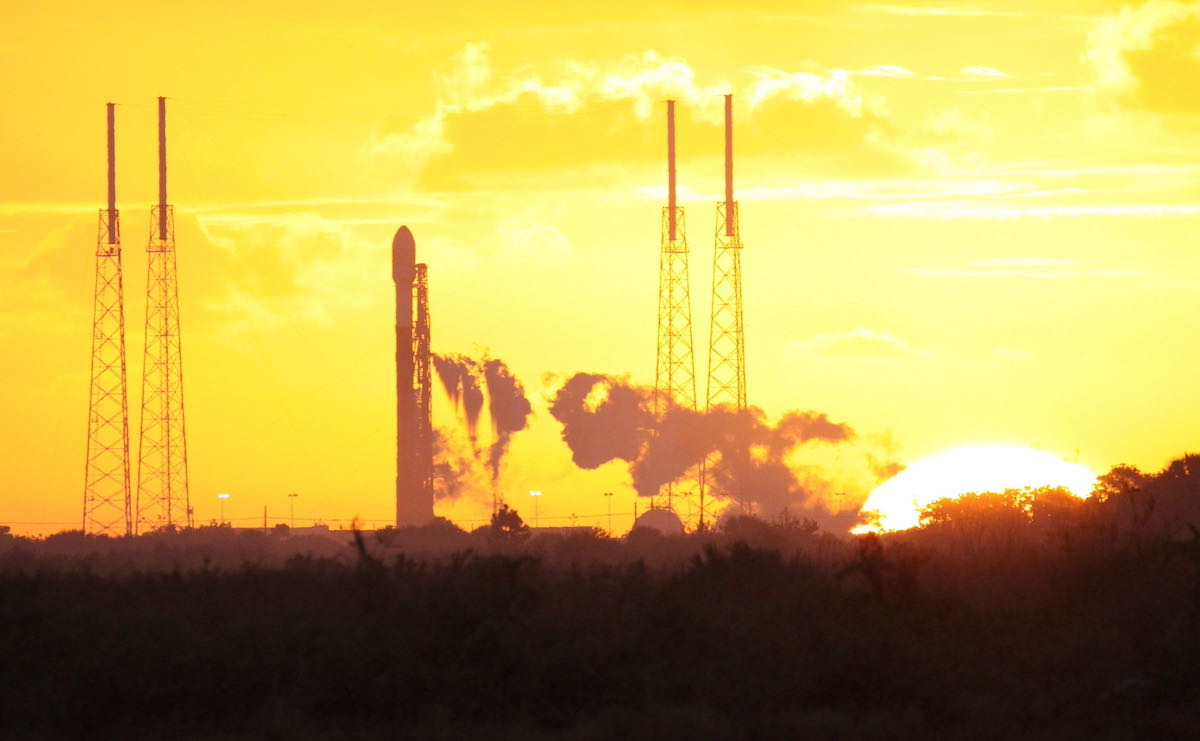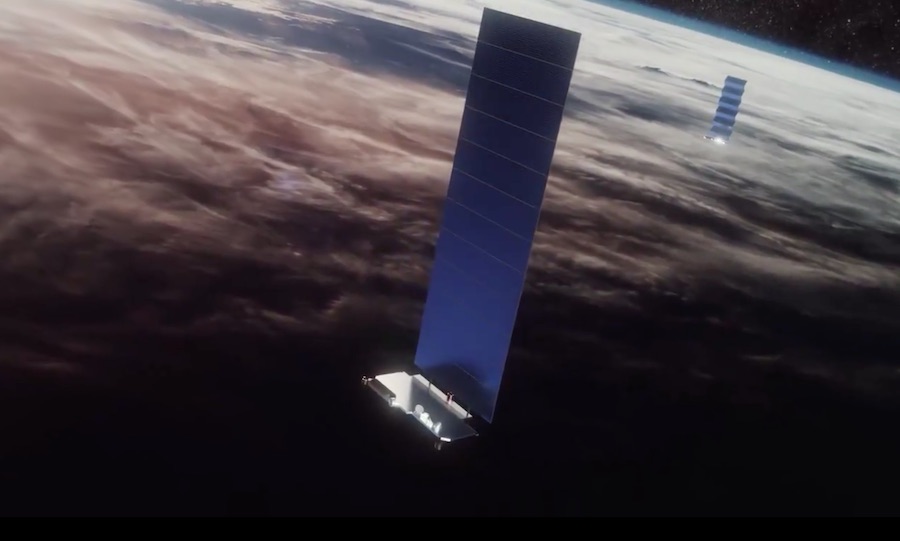Just ten hours after launching a crew capsule from a nearby pad, SpaceX ignited the main engines on a reused Falcon 9 rocket at Cape Canaveral Space Force Station Thursday morning for a brief test-firing ahead of a planned liftoff Friday to begin a new phase of deploying the company’s Starlink satellite internet network.
Already loaded with its payload of 53 satellites, the Falcon 9 launcher ignited its nine Merlin booster engines at 7 a.m. EST (1200 GMT) Friday on pad 40 at Cape Canaveral. The engines ran for around seven seconds, throwing up to full power to generate 1.7 million pounds of thrust.
Clamp restraints kept the 229-foot-tall (70-meter) rocket firmly on the ground at pad 40. SpaceX tweeted less than 90 minutes later to confirm the test-firing, or static fire test, and confirm the launch was on schedule for Friday.
Liftoff with 53 Starlink satellites is scheduled for an instantaneous opportunity at 7:41 a.m. EST (1241 GMT) Friday on SpaceX’s 25th Falcon 9 launch of the year.
In the official launch weather forecast from the U.S. Space Force’s 45th Weather Squadron, meteorologists predict a 60% chance of acceptable conditions for liftoff Friday morning.
Forecasters expect cloudy skies and scattered rain showers around Cape Canaveral, with winds from the northwest at 5 to 10 mph and a temperature around 70 degrees Fahrenheit.
The primary weather concerns Friday are the chances that conditions at the launch base will violate the thick cloud and disturbed weather rules.
“Abundant moisture and vertical forcing along a pre-frontal boundary moving through the area on Friday morning will spur the development of thick low-level cloud layers and scattered showers, with thick clouds and disturbed weather as the main launch concerns for the primary launch window,” the Space Force weather officer wrote in a forecast issued Thursday.
If the launch is delayed to a backup opportunity Saturday morning, forecasters predict an 80% chance of favorable weather for liftoff.

In preparation for the static fire test and launch, SpaceX rolled the Falcon 9 rocket from its hangar to the launch mount at pad 40, then raised the vehicle vertical Wednesday.
For a few hours Wednesday, SpaceX’s two launch pads on Florida’s Space Coast were both occupied by Falcon 9 rockets. A few miles to the north of pad 40, a Falcon 9 rocket was awaiting blastoff from pad 39A at NASA’s Kennedy Space Center carrying four astronauts to the International Space Station.
That mission took off at 9:03 p.m. EST Wednesday (0103 GMT Thursday). The Falcon 9 deployed the Crew Dragon Endurance spacecraft into orbit about 12 minutes later, beginning a 22-hour pursuit of the space station with commander Raja Chari, pilot Tom Marshburn, and mission specialists Matthias Maurer and Kayla Barron.
The successful launch cleared the way for SpaceX to continue preparations for the next Starlink mission a few miles down the road at pad 40.
The 53 satellites stacked on top of the rocket will be the first to populate a new orbital shell in SpaceX’s Starlink fleet.
Predicted orbit data shared by SpaceX with satellite trackers and space traffic managers indicated the mission will aim to release the 53 satellites into an orbit tilted 53.2 degrees to the equator, with a high point, or apogee, of 210 miles (339 kilometers), and a perigee, or low point, of 131 miles (212 kilometers).
SpaceX’s Falcon 9 rocket will head northeast from Cape Canaveral, and shed its first stage booster about two-and-a-half minutes into the mission. The first stage is designated B1058 in SpaceX’s inventory of reusable rockets, and is a veteran of eight prior missions, beginning with the historic launch of SpaceX’s first crew test flight for NASA in May 2020.
The booster will attempt to land on SpaceX’s drone ship “Just Read the Instructions” in the Atlantic Ocean, while the second stage will fire into orbit with a single burn of its Merlin engine. Deployment of the 53 Starlink payloads is expected at T+plus 15 minutes, 31 seconds, according to a mission timeline provided by SpaceX.

Most of the Starlink satellites launched so far have deployed into a 341-mile-high (550-kilometer), 53-degree inclination orbit, the first of five orbital “shells” the company plans to complete full deployment of the Starlink network. SpaceX completed deployment of satellites in that shell with a series of Starlink missions launched from Cape Canaveral from May 2019 through May of this year.
Since May, SpaceX has rushed to complete development of new inter-satellite laser terminals to put on all future Starlink satellites. The laser crosslinks, which have been tested on a handful of Starlink satellites on prior launches, will reduce the reliance of SpaceX’s internet network on ground stations.
The ground stations are expensive to deploy, and come with geographical — and sometimes political — constraints on where they can be positioned. Laser links will allow the Starlink satellites to pass internet traffic from spacecraft to spacecraft around the world, without needing to relay the signals to a ground station connected to a terrestrial network.
The completion of the first Starlink “shell” enables the network to provide high-speed, low-latency internet services to lower latitudes, such as the southern United States. The partial deployment of satellites into the first orbital shell initially provided service over northern regions of the United States, Canada, and Europe, as well as higher-latitude regions in the southern hemisphere.
SpaceX, founded and led by billionaire Elon Musk, is currently providing interim internet services through the Starlink satellites to consumers who have signed up for a beta testing program.
In September, SpaceX launched the first batch of 51 Starlink satellites into a 70-degree inclination orbit on a Falcon 9 rocket from Vandenberg Space Force Base. That orbital shell will eventually contain 720 satellites at an altitude of 354 miles (720 kilometers).
Aside from the 53-degree and 70-degree orbital shells, SpaceX’s other Starlink layers will include 1,584 satellites at 335 miles (540 kilometers) and an inclination of 53.2 degrees, and 520 satellites spread into two shells at 348 miles (560 kilometers) and an inclination of 97.6 degrees.
The satellites awaiting launch Friday will unfurl their solar panels and switch on their plasma engines after separating from the Falcon 9 rocket, beginning maneuvers to climb into a circular orbit 335 miles above Earth to begin filling the 53.2-degree inclination shell.
SpaceX has regulatory approval from the Federal Communications Commission for approximately 12,000 Starlink satellites. The company’s initial focus is on launching 4,400 satellites on a series of Falcon 9 rocket flights. SpaceX’s next-generation launcher, a giant rocket called the Starship that has not yet reached orbit, may eventually be tasked with launching hundreds of Starlink satellites on a single mission.
The launch Friday will bring the total number of Starlink spacecraft SpaceX has launched to 1,844 satellites, including failed and decommissioned spacecraft, adding to the largest fleet ever put into orbit. It will be the 31st dedicated Falcon 9 launch for the Starlink network.
SpaceX builds the Starlink satellites, each with a mass of about a quarter-ton, in a factory in Redmond, Washington.
A tabulation by Jonathan McDowell, an astronomer and respected tracker of spaceflight activity, shows SpaceX currently has 1,454 operational Starlink satellites, with nearly 100 additional craft moving into their operational positions in orbit.
Email the author.
Follow Stephen Clark on Twitter: @StephenClark1.
© 1999-2024 Spaceflight Now Inc
